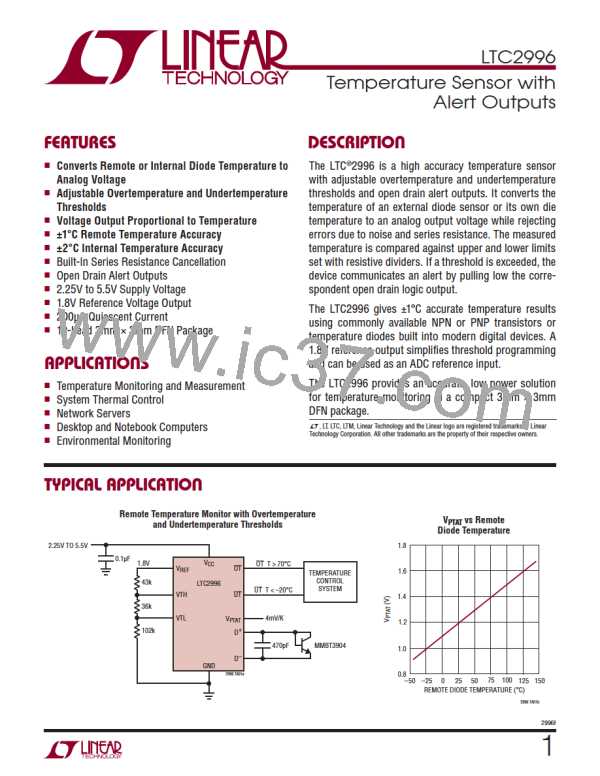LTC2996
applicaTions inForMaTion
Note that bypass capacitors greater than 1nF will cause
settling time errors of the different measurement cur-
rents and therefore introduce an error in the temperature
measurement (see Typical Performance Characteristics).
The LTC2996 can withstand up to 4kV of electrostatic
discharge (ESD, human body model). ESD beyond this
voltage can damage or degrade the device including
lowering the remote sensor measurement accuracy due
+
–
to increased leakage currents on D or D .
The LTC2996 compensates series resistance in the
measurement path and thereby allows accurate remote
temperature measurements even with several meters of
distance between the sensor and the device. The cable
lengthbetweenthesensorandtheLTC2996isonlylimited
To protect the sensing inputs against larger ESD strikes,
external protection can be added using TVS diodes to
ground (Figure 3). Care must be taken to choose diodes
with low capacitance and low leakage currents in order
nottodegradetheexternalsensormeasurementaccuracy
(see Typical Performance Characteristics curves).
+
by the mutual capacitance introduced between D and
–
D which degrades measurement accuracy (see Typical
Performance Characteristics).
LTC2996
10Ω
10Ω
+
–
For example, a CAT6 cable with 50pF/m should be kept
shorter than ~20m to keep the capacitance less than 1nF.
D
D
MMBT3904
220pF
GND
To save wiring, the cathode of the remote sensor can
2996 F03
PESD5Z6.0
–
also be connected to remote GND and D to local GND
as shown below.
Figure 3. Increasing ESD Robustness with TVS Diodes
LTC2996
+
D
470pF
2N3904
–
D
GND
To make the connection of the cable to the IC polarity
insensitive during installation, two sensor transistors
with opposite polarity at the end of a two wire cable can
be used as shown on Figure 4.
2996 F02
Figure 2. Single Wire Remote Temperature Sensing
LTC2996
+
The temperature measurement of LTC2996 relies only
on differences between the diode voltage at multiple test
circuits.ThereforeDCoffsetssmallerthan300mVbetween
remote and local GND do not impact the precision of the
temperature measurement. The cathode of the sensor
can accommodate modest ground shifts across a system
which is beneficial in applications where a good thermal
connectivity of the sensor to a device whose temperature
is to be monitored (shunt resistor, coil, etc.) is required.
Care must be taken if the potential difference between
D
MMBT3904
470pF
–
D
GND
2995 F04
Figure 4. Polarity Insensitive Remote Diode Sensor
Again, care must be taken that the leakage current of the
second transistor does not degrade the measurement
accuracy.
–
the cathode and D does not only contain DC but also AC
components. Noise around odd multiples of 6kHz ( 20%)
is amplified by the measurement algorithm and converted
toaDCoffsetinthetemperaturemeasurement(seeTypical
Performance Characteristics).
2996f
10

 Linear [ Linear ]
Linear [ Linear ]